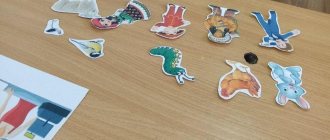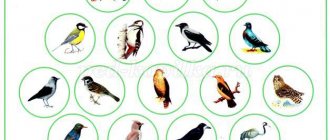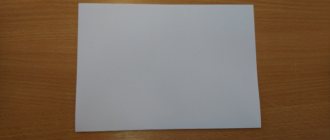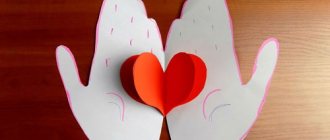Types of paper for creativity
Although many mothers are accustomed to buying packaging by eye, without paying attention to the type of paper.
In fact, this is the first thing to consider when purchasing. There are many types and here are the most common ones:
Regular
There are no identifying marks on the packaging of this paper.
It can be one-sided or two-sided.
The first one is suitable if you need to make an applique. Its reverse side is white, so it is not suitable for voluminous crafts. Double-sided can be used for any homemade products.
Please note that there are no specific classifications, so study the surface of the paper.
Bad paper is low-density, the painted surface shows through, and wrinkles easily.
It is very difficult to work with: the glue constantly gets wet, it is easy to tear and ruin. Good sheets are dense, have a smooth, bright surface, and tolerate glue well.
If you want your child to be happy, buy paper with a density of at least 60 g/m2.
Velvet paper
It has a characteristic “velvety” texture, very pleasant to the touch, slightly voluminous. For ordinary applications, such paper is rarely used - it is too expensive, but for postcards or kindergarten crafts it is well suited.
A good velvet sheet is evenly covered with flock, the surface is uniform and smooth. It should not break at the bend.
Holographic paper
Shiny paper that will decorate any craft well. One side of the sheet is covered with iridescent foil, which is tightly glued to the paper.
The holographic design shimmers in the light and often has an ornament. By the way, in addition to appliques, it is often used for costumes for the holidays.
Creped
Crepe paper has characteristic irregularities along its entire surface, which is why it resembles an elastic band.
It stretches well and is more suitable for voluminous crafts.
It is not suitable for appliqués and origami - crepe paper is intended for three-dimensional compositions.
By the way, it is sometimes sold under the name “corrugated”.
For origami
A special grade of paper with high density. It feels more like thin cardboard to the touch, but is easy to turn out and fold.
What distinguishes it from ordinary colored paper is:
- Saturated color. It's bright but not glossy. Almost always has a characteristic dullness and uniform color.
- Strength. Due to the increased density, colored origami paper does not rub on the folds and does not form an “accordion”. It is better suited for complex figures, since it does not deteriorate when turned out and folded repeatedly.
- Form. Almost always sold in a square format because most figures are assembled from this figure.
For quilling
Until recently, it was necessary to manually cut sheets into thin strips; now quilling paper is sold ready-made. Its qualities are similar to the previous one: durable and wear-resistant. When twisted, it does not lose its shape and sticks easily.
For scrapbooking
Special paper for crafts that has an original design or texture.
Designed for decorating notebooks, boxes, creating smashbooks.
For scrapbooking, there is also fluorescent paper that glows in the dark in different colors.
"Paper Collector" Lesson for preschoolers ⋆ Planet of Childhood
Program content:
- expand children’s understanding of different types of paper and its qualities;
- improve the ability to identify objects based on material characteristics;
- develop imagination and intelligence;
- to form a careful attitude towards natural resources.
Material : samples of different types of paper; paper objects (album, newspaper, box, etc.).
Progress of the lesson
Educator: Hello guys. Today we will visit paper. Let's see what's on your tables?
Children: Paper.
Educator: Let's look at it carefully. Tell me, is it all the same? How can you determine?
Children: She is different. You can stroke it, touch it.
Educator: Yes, paper can be smooth and rough, thick, thin, soft and not very soft. Who knows the types of paper? (color, landscape, cardboard, napkins, velvet, etc.). Do you know where paper came from?
Man invented writing material long before paper appeared. The ancient Egyptians, about 4,000 years ago, took stems of papyrus, peeled off the skin and straightened it. Then the strips of papyrus were laid crosswise and pressed so that they stuck together. A dried sheet of papyrus provided good writing material.
But it wasn't paper yet. It was invented in China around 105 by a man named Cai Lun. He found a way to make paper from the fibrous inner bark of the mulberry tree.
The Chinese learned to grind the bark in water to separate the fibers, then they poured the mixture onto trays with long, narrow strips of bamboo at the bottom. When the water drained, the soft sheets were laid to dry on a flat surface. Bamboo and old rags were used for this purpose. Later, someone figured out how to improve the quality of paper by adding starch to it.
And now people make paper from different types of trees.
Conversation “Wood is the source of paper.”
Goal: to teach children to be careful with paper.
- Now try to crumple a sheet of paper? Wrinkles? (Twists, bends). (Children's answers). Now tear it up. Is it torn? Sturdy paper?
Children: Paper tears, which means it is fragile.
Educator: Now put a sheet of paper in a container of water. What happens to the paper?
Children: She gets wet.
Educator: Now look what happens to the paper (torn into pieces). Do you think it is possible to join the paper? How? (Glue, sew, intertwine). So, what properties of paper have you learned?
Children: The paper wrinkles, tears, gets wet in water, burns.
Educator: We will use the ability of paper to tear, crumple, bend and join by gluing and weaving in further work.
Physical education minute.
Educator: Guys, this morning the postman brought a telegram. Now I will read it to you:
"Dear friends! I am a collector, I collect different types of paper. I travel to cities and villages and tell everyone about my collection. But in your city, something bad happened to me: a strong wind blew, and my collection scattered, and part of the collection ended up in your group. Please, please find her."
Guys, can we help? Let's look for paper samples in the group.
(Children look for and bring samples previously hidden in the room.)
There is a knock and a collector comes in.
Collector: Thank you very much! You saved my collection! I have long been interested in collecting paper, and I have all types written down. Let me now name the type of paper, and you show me a sample.
Napkin, newspaper, postcard, photograph, box, glossy, copy paper, Whatman paper, wallpaper, notebook, magazine, calendar.
(The collector explains the purpose of each type of paper along the way).
Collector: Paper is an amazing material, one of the most accessible, we encounter it every day. Look around books, newspapers, notebooks, wallpaper, various packaging - it's all paper.
Take a closer look, touch it with your fingers, squeeze it into a fist, tear it: it is plastic, ready to take any shape.
Try, and the sheet of paper will be obedient to your hands, you will be able to create a fantastic, fairy-tale world!
Game “Guess what paper?” - Let's look at the objects on the table, tell me what kind of paper they are made of? (Cardboard box, flower made of colored paper, hat made of newspaper, etc.).
Educator: Thank you, collector, for an interesting conversation. We will use different types of paper in our work, and then we will invite you and show you what we have done.
(The collector leaves).
Educator: Guys, what types of paper did we meet today? What crafts can be made from cardboard? from the newspaper? from colored paper?
Smirnova Antonina Petrovna, teacher of the MDOU “DSKV No. 62”, Leningrad region, Vsevolozhsk district,
Koltushi village, Russia.
The article is published in the author's edition.
Source: https://planetadetstva.net/vospitatelam/starshaya-gruppa/kollekcioner-bumagi-zanyatie-dlya-doshkolnikov.html
Which colored paper is best for crafts?
Based on the properties of craft paper, it becomes clear that a certain type is suitable for specific crafts.
Application
In the application it is important to observe several qualities:
- Brightness;
- Accents;
- Uniformity.
Good, thick colored paper is suitable for this case. It will not “ripple” when saturated with glue, nor will it change shape after drying.
You can also use velvet sheets. They're good for emphasis. If you use the appliqué style - decoupage, then you cannot do without velvet.
Polished paper, also known as coated paper, will help with bright compositions. Its glossy surface is much richer and more variegated than that of a regular one.
Papier mache
Traditionally, papier-mâché is made from newspaper, although very thin colored paper with double-sided printing is also suitable for these purposes. It is well saturated with paste and takes the required shape.
Quilling
It’s easier to buy a ready-made collection of quilling paper. They are sold in different sets, including for large paintings.
If you want to make a composition from certain colors, but there is no such set on sale, good double-sided colored paper, but not coated, will do.
Preferably with a high density so that the shape holds better.
Origami
It is better to buy special paper, but thick colored paper (uncoated only) will do. You can also use very thin cardboard.
Colorit series assortment
| Color name | Number (article) | Formats, densities | |||
| A4, 80 g/m2 | A3, 80 g/m2 | A4, 110 g/m2 | A4, 160 g/m2 | ||
| Sand Brown | 14 | • | • | • | |
| Lilac (lilac) | 18 | • | • | • | • |
| Amethyst (purple, amethyst) | 19 | • | • | ||
| Salmon (orange-pink, salmon) | 21 | • | • | ||
| Honey | 22 | • | • | • | |
| Rose (pink) | 23 | • | • | • | • |
| Sunrise (sunrise) | 24 | • | • | ||
| Coral Red (coral red) | 25 | • | • | • | • |
| Orange | 27 | • | • | • | |
| Autumn Glow (autumn blush) | 29 | • | • | • | |
| Poppy red (red poppy) | 32 | • | • | • | • |
| Golden Yellow | 42 | • | |||
| Buttercup Yellow | 47 | • | • | • | • |
| Lemon Yellow | 49 | • | • | • | • |
| Sulfur Yellow (greenish yellow) | 51 | • | • | • | • |
| Vanilla (vanilla) | 52 | • | • | • | • |
| Chamois (brown-yellow, suede) | 54 | • | • | • | |
| Spring Green | 57 | • | • | ||
| Meadow Green (bright green with a yellowish tint) | 58 | • | • | • | • |
| Lime Green (linden green) | 59 | • | • | • | • |
| Emerald Green (emerald green) | 60 | • | • | • | |
| Polar Green | 62 | • | • | • | • |
| Kingfisher Blue | 69 | • | • | • | |
| Wedgwood (porcelain) | 70 | • | |||
| Sky Blue (sky blue) | 72 | • | • | • | • |
| Aqua Marine (aquamarine) | 74 | • | • | • | • |
| Sapphire Blue (dark blue, sapphire) | 76 | • | • | • | • |
| Silver Gray | 84 | • | |||
| Dolphin Gray | 87 | • | • | • | • |
| Iron Gray | 89 | • | |||
Types of colored cardboard for creativity
Beautiful crafts for elementary school or kindergarten can be made from cardboard. Unlike paper, it is always easy to use, and even kids have no problems with it.
Please note that cardboard can be coated or uncoated. The first one is more beautiful, but more expensive. It is rarely used in large compositions, especially in papermaking or modeling.
Ordinary
Plain colored cardboard, coated or uncoated. Often used in making cards and congratulations.
Corrugated
It has a characteristic “accordion” shape and pronounced volume. It is often used for framed pictures, which can be given as a gift or to decorate a child’s desk.
Velvet
Like paper, it has a pleasant velvety surface. Easy to cut and not soaked through with glue. Often used in appliques and when gluing boxes.
Foil
It has an unusual iridescent tone with thousands of inclusions. Used as decoration or accent.
Assortment of the flying colors series
| Color name | Number (article) | Formats, densities | |||||
| A4, 80 g/m2 | A3, 80 g/m2 | A4, 120 g/m2 | A4, 160 g/m2 | A3, 160 g/m2 | A4, 200 g/m2 | ||
| White | 02 | • | • | • | |||
| Ivory | |||||||
| pastel | 03 | • | |||||
| Cream | |||||||
| pastel | 04 | • | • | • | |||
| Pink | |||||||
| pastel | 11 | • | • | • | • | ||
| medium | 18 | • | • | • | • | ||
| intensive | 24 | • | • | ||||
| Lilac | |||||||
| pastel | 07 | • | • | ||||
| intensive | 19 | • | |||||
| Blue | |||||||
| pastel | 08 | • | • | • | • | ||
| medium | 14 | • | • | • | • | ||
| intensive | 20 | • | |||||
| Light green | |||||||
| pastel | 09 | • | • | • | • | • | |
| medium | 15 | • | • | • | |||
| intensive | 21 | • | • | ||||
| Yellow | |||||||
| pastel | 10 | • | • | • | • | ||
| medium | 16 | • | • | • | • | ||
| intensive | 22 | • | • | ||||
| Holy pink | |||||||
| pastel | 05 | • | |||||
| Sand | |||||||
| pastel | 12 | • | • | • | • | ||
| intensive | 28 | • | |||||
| Grey | |||||||
| medium | 13 | • | • | ||||
| Terracotta | |||||||
| medium | 17 | • | |||||
| Orange | |||||||
| intensive | 23 | • | • | ||||
| Lilac | |||||||
| intensive | 25 | • | |||||
| Blue | |||||||
| intensive | 26 | • | |||||
| Green | |||||||
| intensive | 27 | • | |||||
| Red | |||||||
| intensive | 29 | • | |||||
| Bordeaux | |||||||
| intensive | 30 | • | |||||
Symphony series range
| Color name | Number (article) | Formats, densities | |||||
| A4, 80 g/m2 | A3, 80 g/m2 | A4, 120 g/m2 | A3, 120 g/m2 | A4, 160 g/m2 | A3, 160 g/m2 | ||
| Pastel Pink (pale pink) | 80 | • | • | • | • | • | • |
| Pastel Blue (pale blue) | 73 | • | • | • | • | • | • |
| Pastel Green (pale green) | 77 | • | • | • | • | • | • |
| Pastel Yellow (pale yellow) | 82 | • | • | • | • | • | • |
| Cream | 109 | • | |||||
| Light Gray | 86 | • | • | • | • | ||
| Salmon (yellow-pink) | 81 | • | • | • | • | ||
| Gold (golden) | 76 | • | • | ||||
| Gray | 94 | • | • | ||||
| Sandbrown | 62 | • | • | ||||
| Light Blue | 93 | • | |||||
| Medium Blue | 89 | • | • | ||||
| Swan Blue (blue swan) | 85 | • | • | • | • | ||
| Light Violet | 84 | • | • | • | • | ||
| Light Green | • | ||||||
| Light Mint (mint) | 92 | • | • | • | • | ||
| Sun Yellow (bright yellow) | 60 | • | • | • | • | • | • |
| Aqua Blue (sea wave) | 50 | • | • | • | • | ||
| Citron Yellow (lemon) | 96 | • | • | • | • | • | |
| Orange | 58 | • | • | • | |||
| Dark Blue (dark blue) | 52 | • | • | • | • | • | • |
| Dark Green (dark green) | 53 | • | • | • | • | • | • |
| Coral Red (red coral) | 51 | • | • | • | • | • | • |
| Lime Green (green lemon) | 54 | • | • | • | • | ||
| Old Rose (dark rose) | 87 | • | • | ||||
| Mint Green (mint green) | 88 | • | • | ||||
| Raps Yellow | 91 | • | • | • | • | ||






